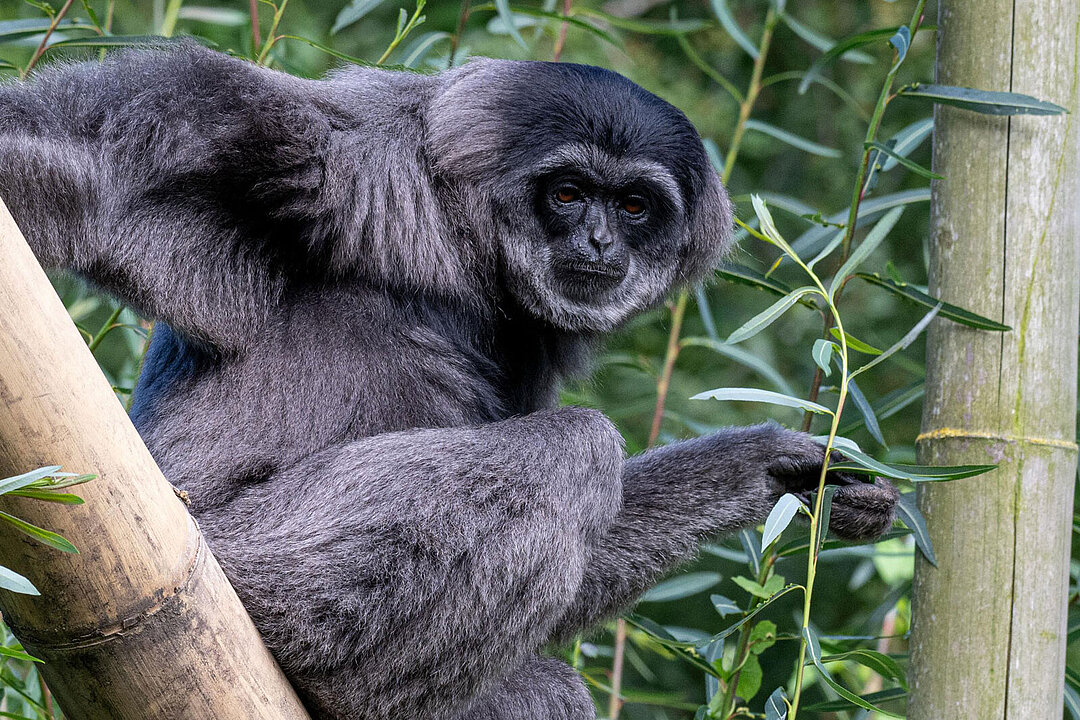![[Translate to English:] A Siamang in the branches.](/fileadmin/_processed_/f/f/csm_tierpark-hellabrunn-siamang-eep_b7095109e3.jpeg)
Today, 24 October, is International Gibbon Day. The day was established by the International Union for Conservation of Nature (IUCN) in 2015 to raise awareness of a lesser known but critically endangered primate family called gibbons. Hellabrunn Zoo is home to two species of gibbons: silvery gibbons and siamangs. In 2024, zoological curator Dr Hanspeter Steinmetz was appointed as head of the EAZA Ex-situ Programme (EEP) for siamangs.
When we think of apes, chimpanzees and gorillas usually spring to mind. But gibbons are also part of the ape family. Native to the forests of East, South and Southeast Asia, in particular Indonesia, these small apes, classified as ‘lesser apes’, are not only excellent climbers, but also known for their powerful singing voices. There are 20 different species of gibbons, all of which are highly endangered. There are many reasons for this: habitat fragmentation in East Asia, deforestation, hunting and illegal pet trade.
As a science-led zoo, Hellabrunn has made it its mission to protect these highly endangered species. Dr Hanspeter Steinmetz, curator and veterinarian at Hellabrunn, has recently been appointed head of the EAZA Ex-situ Programme (EEP) for siamangs, which focuses on species conservation outside of the primates’ natural habitat. His duties include ensuring that the genetic diversity and health of the siamang population in European zoos is maintained.
There are currently 168 siamangs living in 49 zoos in Europe. The EEP for siamangs maintains a database of all relevant information for each individual. Steinmetz also provides breeding and transfer recommendations and keeps track of the reproductive opportunities and gender distribution of the gibbons in the various zoos.
"The EAZA Ex-situ Programmes are an important measure when habitats are severely threatened or wild populations have become so small that they cannot survive without human help. Ex-situ species conservation also offers opportunities for research, education and raising public awareness about conservation," explains Steinmetz.
Siamangs are the largest and loudest of the gibbons. At almost twice the size of other gibbons, they can reach up to 1 m in height. Their distinctive song can be heard frequently in Hellabrunn Zoo. There are currently two siamangs living in the World of Small Monkeys. "Since only four percent of the siamangs' habitats are protected, we are committed to working with our partners in the EEP to save the rainforests of Southeast Asia," adds Dr Steinmetz.
The somewhat smaller silvery gibbons can only be seen in one other zoo in Germany besides Hellabrunn. In their native habitat, the Indonesian island of Java, conservationists estimate that only around 2,500 individuals remain in the wild. "Based on the premise that we protect what we get to know, our silvery gibbons and siamangs act as ambassadors for their fellow species in Southeast Asia and help us better understand these highly endangered primates and raise awareness about conservation," says zoo director Rasem Baban. Both gibbon species play an essential role in their ecosystem by helping to disperse seeds and preserve forest structure.
Gibbons have a lifespan of up to 35 years, but in captivity some can even reach the age of 50 years or more. They live with their young in small family groups of up to six individuals. Gibbons are typically monogamous – a pair stays together for life.
Here in Germany, everyone can help save the forest habitats of the gibbons and many other animals by buying cosmetic products and food with a sustainable palm oil label or choosing paper and wood with FSC certification. More information about gibbons and conservation efforts to protect them can be found on the IUCN website: https://gibbons.asia/what-you-can-do/
